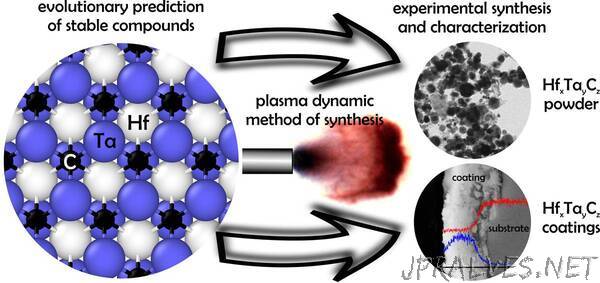
“Researchers from Skoltech and Tomsk Polytechnic University have used an unusual technique from the aerospace industry to synthesize hafnium-tantalum carbide, a hard-to-melt material for coating electrical and mechanical components that operate under extreme conditions. Inexpensive and effective, their plasma dynamic method can produce high-quality carbide both as powders and as coatings on diverse substrates. The research findings are reported in Advanced Functional Materials.
Transition-metal carbides are industrially important materials with ultrahigh melting temperatures, impressive hardness and wear resistance. Among them, the carbides of hafnium and tantalum can withstand the highest temperatures — close to 4,000 degrees Celsius — without melting. Interestingly, some of the mixed carbides of these two metals hold the promise of an even higher melting point, making hafnium-tantalum carbides potentially useful for hardware and electronics operating under extreme conditions. Beyond that, they could prove applicable as catalysts for producing hydrogen from water.
The conventional approaches to the synthesis of materials with high melting points, among them transition-metal carbides, rely on peculiar sintering methods, isostatic pressing, and other techniques that require high vacuum or extreme pressures. Such conditions are technologically challenging, and on top of that, the source materials need to be ground into very fine powders, so those methods are expensive and resource-intensive. Now, Skoltech and TPU physicists and their colleague from Pirogov University have used an effective, and more economical, technique called plasma dynamic synthesis to obtain high-quality compounds of hafnium, tantalum, and carbon both in the form of powders and as coatings that can be deposited on diverse substrates.
The technique involves accelerated pulsed plasma flows and goes back to aerospace tech from the mid-1960s. It was originally developed with a view to exploiting the generated hypersonic flows in plasma guns and space engines. Eventually, several plasma accelerator designs were proposed and by the turn of the century, the scope of their applications expanded to include the synthesis of various functional materials.
The recent study in Advanced Functional Materials reports the adaptation of one such technology — plasma dynamic synthesis — to the production of hafnium-tantalum carbide.
“We employ a unique experimental setup developed at TPU, called the coaxial magnetic plasma accelerator. First we place the source materials — powdered carbon and the oxides of hafnium and tantalum — into the accelerator and pump a lot of energy into storage capacitors. Once the capacitors are discharged, this gives rise to an electric arc instantly turning the source materials into a plasma flow hitting the reactor wall at 5 kilometers per second. Then we just scrub off the end material and there it is,” study co-author Associate Professor Dmitry Nikitin of TPU recounted.
The lead author of the study, Assistant Professor Alexander Kvashnin from Skoltech, commented: “We have used modern computational methods in making precise predictions of novel compounds with desirable properties, and combined those methods with experimental techniques that are unusual for this type of compounds, arriving at an inexpensive and selective synthesis of those new compounds and functional materials based on them.”
The team predicted 10 phases of hafnium-tantalum carbide that differ in the relative proportion of the two metals in the resulting material and synthesized them all using the unique experimental setup. “This shows that, unlike the other methods, ours allows product composition to be controlled with high selectivity and precision,” Kvashnin said.
Besides being less demanding to source materials and reactor conditions, the team’s plasma dynamic synthesis method doubles as a technique for depositing hafnium-tantalum carbide coatings on arbitrary surfaces. “Some of the 10 compounds predicted in this study were not just synthesized as powders but also deposited as coatings on a piece of copper,” Kvashnin added.
According to the researchers such hard alloy coatings could be used for thermal and electrical insulation, as well as for protection from mechanical damage. “Supposing that piece of copper was a cable, by coating it with hafnium-tantalum carbide, we made that cable about 10 times harder, and electrically insulated and heat-shielded it into the bargain,” the researcher went on. “Other components that operate under harsh conditions could also benefit from such coatings. For example, you could coat the balls in a ball bearing to considerably boost its wear resistance.”
The head of TPU’s Energy of the Future strategic project under the Priority 2030 program, Alexander Pak, commented on the results of the study: “What also makes this research important is that the predicted and synthesized nanopowders of metal carbide might find applications in catalytic systems for hydrogen production by water splitting. This serves to show that the collaboration between TPU’s Ecoenergy 4.0 Research Center and Skoltech’s Project Center for Energy Transition and ESG can result in impressive new materials for the energy industry.””
